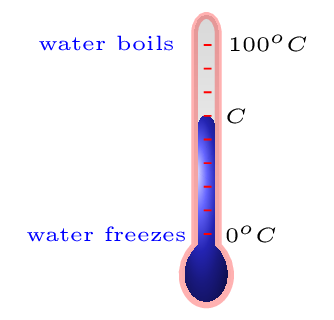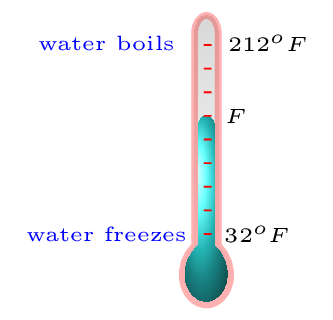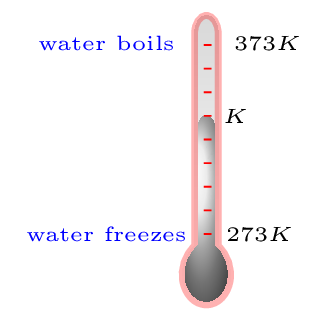Subsection 10.1.1 Temperature and Thermometers
There are varieties of thermometers in existence. Based on the phases of materials used in thermometer they are solid state thermometer, liquid thermometer, and gas thermometer. Many physical properties of materials change significantly with temperature can be used as the basis for constructing thermometers. Solid thermometer works upon the principle that resistances of solid objects are proportional to changes in its temperature. Liquid thermometer works upon the principle that expansion in liquid volume are proportional to changes in its temperature. Gas thermometer works upon the principle that changes in gas pressure are proportional to changes in gas temperature. Here mainly discussed about liquid thermometer. Liquid thermometers, such as mercury-in-glass or alcohol thermometers, have been widely used for temperature measurement for many years. However, due to toxic effect of mercury for living being mercury thermometers are not much in use these days. The different calibration process of thermometers produces different types of temperature scales. They are Centigrade (Celsius) scale [Figure 10.1.1.(a)], Fahrenheit scale[Figure 10.1.1.(b)], and Kelvin scale [Figure 10.1.1.(c)]. There are some other types of scales like Rankine’s or Reamer’s thermometers available but they are almost obsolete. A centigrade thermometer has 100 divisions between the freezing point (0 degree Celsius) and the boiling point (100 degree Celsius) of water. Swedish astronomer Andres Celsius is credited for its development. A temperature of 76 degree Celsius is abbreviated as \(76^{o}C.\) The Celsius scale is the most widely accepted temperature scale in the world except the United States. In Fahrenheit thermometer, there are 180 divisions between the freezing point (32 degree Fahrenheit) and the boiling point (212 degree Fahrenheit) of water. German physicist Daniel Fahrenheit is credited for its development. It is the first modern thermometer developed in 1714. A temperature of 76 degree Fahrenheit is abbreviated as \(76^{o}F.\)



Kelvin scale of temperature is the standard metric system of temperature measurement and mostly used by scientists. The Kelvin scale has 100 equal degree increments between the freezing point and the boiling point of water just as the Celsius scale. However, the zero-degree mark on the Kelvin scale is 273.15 units cooler than it is on the Celsius scale. So a temperature of 0 Kelvin is equivalent to a temperature of \(-273.15^{o}C.\) Traditionally, degree symbol is not used with the Kelvin scale. So a temperature of 300 units above 0 Kelvin is referred to as 300 Kelvin and not 300 degree Kelvin. Hence 300 Kelvin is abbreviated as 300 K. Conversions among Celsius, Fahrenheit, and Kelvin scales are summarized below.
Consider these thermometers are placed in a cup of coffey where Celsius scale reads a temperature of C, Fahrenheit scale reads a temperature of F, and Kelvin scale reads a temperature of K, then we can find their relationship as follows
\begin{equation*}
\frac{X-L}{U-L}=\frac{C-0}{100-0}=\frac{F-32}{212-32}=\frac{K-273}{373-273}
\end{equation*}
Here \(X, \,U,\) and \(L\) are unknown temperature, boiling point of water, and freezing point of water in the respective thermometers, respectively. We have used here freezing point of water as 273 K instead of 273.15 K, just for simplicity.
\begin{equation*}
\text{or,}\quad \frac{C}{100}=\frac{F-32}{180}=\frac{K-273}{100}
\end{equation*}
\begin{equation}
\therefore\quad \frac{C}{5}=\frac{F-32}{9}=\frac{K-273}{5}\tag{10.1.1}
\end{equation}
Eqn. (10.1.1) provides the temperature conversion between any two scales. Such as for Celsius/Kelvin scale,
\begin{equation*}
C = ( K - 273)^{o} \,C,
\end{equation*}
\begin{equation*}
\text{and}\quad K = (C + 273) \,K
\end{equation*}
For Fahrenheit/Celsius scale,
\begin{equation*}
F = \left(\frac{9}{5} C + 32\right)^{o}\,F
\end{equation*}
\begin{equation*}
\text{and}\quad C = 5\left(\frac{F - 32}{9} \right)^{o} \,C
\end{equation*}
